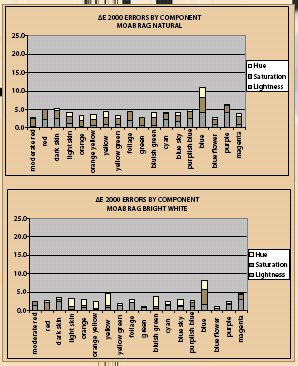articles/Paper/moablegion-page2
Paper Chase Moab Paper by Legion - part 2 of 1 2
by Mike McNamee Published 01/08/2009

These are very good statistics from both papers but note the exceptional performance of the Bright White, with generally lower histogram error bars.
Entrada Rag Bright and Entrada Rag Natural
These surfaces are available on either a 190gsm or a 300gsm base paper. As the name suggests the Bright variant contains OBAs, the Natural does not. The web profiles turned out very good statistics, way above average in the case of the Bright White - it is extremely rare for a canned profile to deliver an error of around 2.0 ΔE2000.
The only flaws in an otherwise impeccable performance were the Granger Chart of the Bright showed a single discontinuity in one part of the green gamut and the Natural had a discontinuity in the grey scale ramp at around 30% Lab Lightness value. Neither of these issue was detected in 'real' prints although we may not have hit the spot in terms of exposing the flaws.

TOP: We can use all the statistical analysis we choose but
in the end we always have to make real prints to get a feel
for how a paper performs. Here we proof out Damian McGillicuddy's
image shot at the DPM Wallbank show on both
Entrada Natural and Bright White papers.
ABOVE: The chroma error chart shows the better performance
of the Bright White profile. This is quite unusual, OBAs
often impair the accuracy of a print. The tighter clustering
of the red (Bright White) data points indicates the superior
control over image saturation.
All the statistics were good (see table). Metamerism and Dmax were normal for this type of paper (as against the claims of 'large gamut, high Dmax' etc!). The gamut volumes, measured on Moab's own profiles, were as shown in the table, they are lower than all those measured on Canson paper for example. The high errors were in the yellow and blue. The yellow in particular was a slightly acidy green. The saturation errors (chroma) were low, particularly the Bright White and they are plotted for comparison. The red data points (Bright White) are clustered closer to the axis than the blue (Natural) data points. The histograms show the 'signature' of the errors to be similar.
Overall, though, this is a really good pair of papers, delivering very high accuracy from the canned profiles and with no serious flaws in the printed output, they are well worth a good look if quality is your main aim.
Please Note:
There is more than one page for this Article.
You are currently on page 2 Contact Mike McNamee
1st Published 01/08/2009
last update 09/12/2022 14:56:47
More Paper Articles
There are 0 days to get ready for The Society of Photographers Convention and Trade Show at The Novotel London West, Hammersmith ...
which starts on Wednesday 15th January 2025





